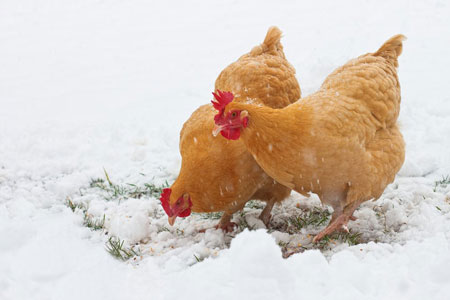
“It’s time to prepare your chicken coop for winter,” reminds Jeff Smith of Cackle Hachery®. “Since there is a current shortage of some items, make a list of materials you need and buy them now. Any repairs need to be done before weather comes in.” The two biggest winterizing issues to keep in mind are coop moisture and windy or drafty conditions.
Eliminate Drafts
“You might need a roll of heavy clear plastic to cover windows and other open areas to block winter weather and eliminate drafts,” says Jeff. “Cover all wired-in doors and windows. You don’t want to make the coop completely tight, as you still need ventilation for exchange of air.
“If the coop is portable, consider putting the run pen on the south side. Then use plastic to cover up the pen on the north or northwest side.”
Comfort Roosts
“Make sure your coop is fitted with comfortable roosts that allow the chickens get a good grip,” Jeff advises. “While they’re roosting, their feathers should cover their feet and toes well.”
Predator Resistance
“During winter, predators that run out of food sources will try to break through wire fence, dig underneath, or come through windows and doors,” Jeff points out. “Now is the time to rethink design and make repairs or improvements.”
Besides making the coop and run predator resistant, the flock should be locked inside the coop during the night. Using an automatic door closer will ensure that you don’t inadvertently forget to secure the pophole.
And remember that predators include rodents. In addition to sometimes biting, they can bother chickens by scurrying around at night, preventing the flock from getting a good night’s sleep, not to mention eating copious amounts of feed while they’re at it. If your coop attracts rodents, consider removing feeders overnight to eliminate temptation.
Drinking Water
Provisions must be made to maintain an adequate water supply through winter. “Find and clean all winter waters, so they are ready to use,” Jeff suggests. “Having water that is not frozen is important for the health of your flock, so consider using a winter style for your watering system.”
Some drinkers easily may be adapted to a heating system. For example, Cackle Hatchery offers a galvanized heating base with a preset thermostat that turns the heater on at 35ºF and off at 45ºF. In the event the power goes out, Jeff suggests combining the heating base with a rubber pan, which frozen water may be broken out of without damaging the pan.
An alternative to using a water pan is a heating base combined with an enclosed top-fill fount. “This tough combo will last for many seasons of use,” Jeff says, adding that with this set-up chickens can’t step into their drinking water. Without coop electricity for a water heater, frozen water must be replaced by warm water at least twice a day.
Coop Electricity
Another advantage to having electricity at the coop is that you can provide 14 to 16 light hours to keep your hens laying during the short winter days. Use a timer to provide a little extra light both morning and evening, allowing the chickens at least 8 hours of darkness so they can sleep undisturbed.
Although, for good flock health, a chicken coop typically should not be heated, if the temperature inside your coop hovers around freezing, or below, for long, your flock may benefit from a little extra warmth. Avoid using a heatlamp, which could get knocked into the litter and start a fire.
A better option is an infrared panel hung above the roost, so chickens can choose to sleep underneath it or not. Putting the heater on a preset thermostat will both keep the coop from overheating and save electricity.
Feed for Warmth
Chickens need more energy to stay warm in winter, so be prepared to boost your flock’s ration to help them generate body heat. Increase carbohydrates by either using a lower protein ration or offering the flock a little scratch grain just before they go to roost. Digesting the grain during the night will help the birds stay warm.
Start Clean
“Power wash inside the coop while good weather still allows it to dry up well,” Jeff suggests, “then add new, dry litter.” The purpose of litter on the floor is to absorb manure and moisture, which is especially important in winter when chickens spend more time indoors. Minimizing coop moisture helps prevent frostbite to combs and wattles.
Fresh, fluffy litter also helps maintain warmth by insulating the floor. Wood shavings, especially pine or poplar, make good litter. Chopped wheat straw is a good alternative. While you’re at it, says Jeff, “Clean out all nests and add new nesting material.”
Coop Design
A coop that is built or bought with cold weather in mind, and is well maintained throughout the year, should not need major adjustments before the arrival of winter.
And that’s today’s news from the Cackle Coop.
Gail Damerow is the author of Storey’s Guide to Raising Chickens.


Great article. I usually feed my chickens more scratch in the winter than I do in the summer. So, I like the idea of giving them more scratch in the evening before roosting time. I cannot remember if I do that normally or not but will definitely make sure I do this now. There are lots of good advice in this article. Thank you.
very informative thank you